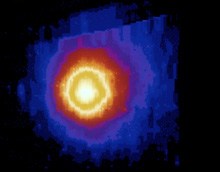We see that Chang'e 3 has achieved lunar orbit and is preparing to land on the Moon.
Things will really get interesting should the landing be successful.
Much to learn about our nearest celestial neighbor.
- LRK -
------------------------------
China’s Maiden Moon Rover Mission Chang’e 3 Achieves Lunar Orbit
China’s maiden moon landing probe successfully entered lunar orbit on Friday, Dec. 6, following Sunday’s (Dec. 1) spectacular blastoff – setting the stage for the historic touchdown attempt in mid December.Engineer’s at the Beijing Aerospace Control Center (BACC) commanded the Chang’e 3 lunar probe to fire its braking thrusters for 361 seconds, according to China’s Xinhua news agency.
The do or die orbital insertion maneuver proceeded precisely as planned at the conclusion of a four and a half day voyage to Earth’s nearest neighbor.
China’s ‘Yutu’ lunar lander is riding piggyback atop the four legged landing probe during the history making journey from the Earth to the Moon.
Read more: http://www.
------------------------------
Dwayne Day talks about the implications of the Chang'e mission.
- LRK -
------------------------------
It’s not bragging if you do itby Dwayne Day
Monday, December 9, 2013
Monday, December 9, 2013
Later this week, if all goes according to plan, China will land a robotic spacecraft and rover on the Moon, something that nobody has done in nearly four decades. If the Chinese do what they did for the launch, they will broadcast much of the event live on television and over the Internet. Last week’s launch coverage on government-controlled English language CCTV was remarkable for its openness. Indeed, the coverage was indistinguishable from Western news coverage of a major space event. There was no propagandizing or nationalistic chest-thumping, just a straightforward reporting with lots of information about the mission and what was happening. The event, and its coverage, highlighted the fact that China has an attractive, technically sophisticated scientific space program that could serve international relations purposes. It was a demonstration of what American political scientist Joseph Nye has referred to as “soft power,” the ability to compel or attract nations to do what you want. China’s space program gives them this ability to attract partners. The problem is that some of China’s other activities undercut their attractiveness as a potential partner.
...
------------------------------
Some more at SPACEFLIGHT NOW
- LRK -
------------------------------
http://www.spaceflightnow.com/
Chinese probe arrives in lunar orbit for moon landing
BY STEPHEN CLARK
SPACEFLIGHT NOW
Posted: December 6, 2013
Chinese probe arrives in lunar orbit for moon landing
BY STEPHEN CLARK
SPACEFLIGHT NOW
Posted: December 6, 2013
Outfitted with a six-wheeled robotic rover and smarts to avoid hazards in the landing zone, Chang'e 3 is China's boldest unmanned space mission to date, extending feats achieved by a pair of lunar orbiters launched in 2007 and 2010.
The four-legged lander fired its propulsion system for six minutes and braked into orbit around the moon at 0953 GMT (4:53 a.m. EST) Friday, according to China's state-run Xinhua news agency.
...
------------------------------
With LADEE looking at the Moon we should get some idea of what going back to the Moon will do to the tenuous lunar atmosphere.
Take a look again at again at what the Planetary Society blog has to say.
------------------------------
Chang'e 3 and LADEE updates -- and Lunar Reconnaissance Orbiter, too, for good measurePosted by Emily Lakdawalla
2013/12/05 08:40 CST
Topics: pretty pictures, Lunar Reconnaissance Orbiter, mission status, LADEE, the Moon, Chang'E program
Update Dec 6 7:54 a.m. PT: Chang'e 3 has arrived in lunar orbit.
Chang'e 3 is just about to land on the Moon, and the LADEE orbiter has begun a new science mission there, while Lunar Reconnaissance Orbiter is still producing amazing images.
Update Dec 6 7:54 a.m. PT: Chang'e 3 has arrived in lunar orbit.
Chang'e 3 is just about to land on the Moon, and the LADEE orbiter has begun a new science mission there, while Lunar Reconnaissance Orbiter is still producing amazing images.
------------------------------
Thanks for looking up with me.
- LRK -
The Moon could be a "beautiful" source of minerals and energy, a top Chinese scientist has told the BBC.
Exotic materials including helium-3 and the potential for solar power could prove invaluable for humankind, he says.
The comments come from Prof Ouyang Ziyuan of the department of lunar and deep space exploration.
His first interview with the foreign media provides insights into China's usually secretive space programme.
Prof Ouyang was speaking ahead of the first Chinese attempt to land an unmanned spacecraft on the lunar surface.
The Chang'e 3 lander is due to launch imminently, perhaps as soon as Sunday evening, UK time.
It will be the first to make a soft touchdown on the Moon since an unmanned Russian mission in 1976
....
==============================
- LRK -
Web Site: http://lkellogg.vttoth.
BlogSpot: http://
WordPress: http://lrkellogg.
RSS link: http://
Newsletter: https://mailman1.
==============================
BlogSpot: http://
WordPress: http://lrkellogg.
RSS link: http://
Newsletter: https://mailman1.
==============================
Moon Treaty
The Agreement Governing the Activities of States on the Moon and Other Celestial Bodies,[2] better known as the Moon Treaty or Moon Agreement, is an international treaty that turns jurisdiction of all celestial bodies (including the orbits around such bodies) over to the international community. Thus, all activities must conform to international law (notably this includes the UN Charter).
In practice it is a failed treaty since it has not been ratified by any nation which engages in self-launched manned space exploration or has plans to do so (e.g. the United States, some member states of the European Space Agency, Russian Federation, People's Republic of China,Japan, and India) since its creation in 1979, and thus has a negligible effect on actual spaceflight. As of 2013, it has been ratified by 15 states.[1]
snip
Ratification
The treaty was finalized in 1979 and entered into force for the ratifying parties in 1984. As a follow-on to the Outer Space Treaty, the Moon Treaty intended to establish a regime for the use of the Moon and other celestial bodies similar to the one established for the sea floor in the United Nations Convention on the Law of the Sea. The L5 Society successfully defeated the treaty in the US Senate.[3]
snip
==============================
Why China is fixated on the Moon
David Shukman
29 November 2013 Last updated at 09:38 ET
Exotic materials including helium-3 and the potential for solar power could prove invaluable for humankind, he says.
The comments come from Prof Ouyang Ziyuan of the department of lunar and deep space exploration.
His first interview with the foreign media provides insights into China's usually secretive space programme.
Prof Ouyang was speaking ahead of the first Chinese attempt to land an unmanned spacecraft on the lunar surface.
The Chang'e 3 lander is due to launch imminently, perhaps as soon as Sunday evening, UK time.
It will be the first to make a soft touchdown on the Moon since an unmanned Russian mission in 1976
....
==============================
Chang'e 3 (Chinese: 嫦娥三号; pinyin: Chán
The spacecraft is named after Chang'e, the goddess of the Moon in Chinese mythology, and is a follow-up to the Chang'e 1 andChang'e 2 lunar orbiters. The lunar rover is called Yutu, or Jade Rabbit, a name selected in an online poll that comes from a Chinese myth about a white rabbit that lives on the Moon as a companion of the moon goddess Chang'e.[11] It achieved lunar orbit on 6 December 2013 (Beijing time).[12]
This article or section documents a current or recent spaceflight. Details may change as the mission progresses
==============================
WHAT THE MIND CAN CONCEIVE, AND BELIEVE, IT WILL ACHIEVE - LRK -
==============================




